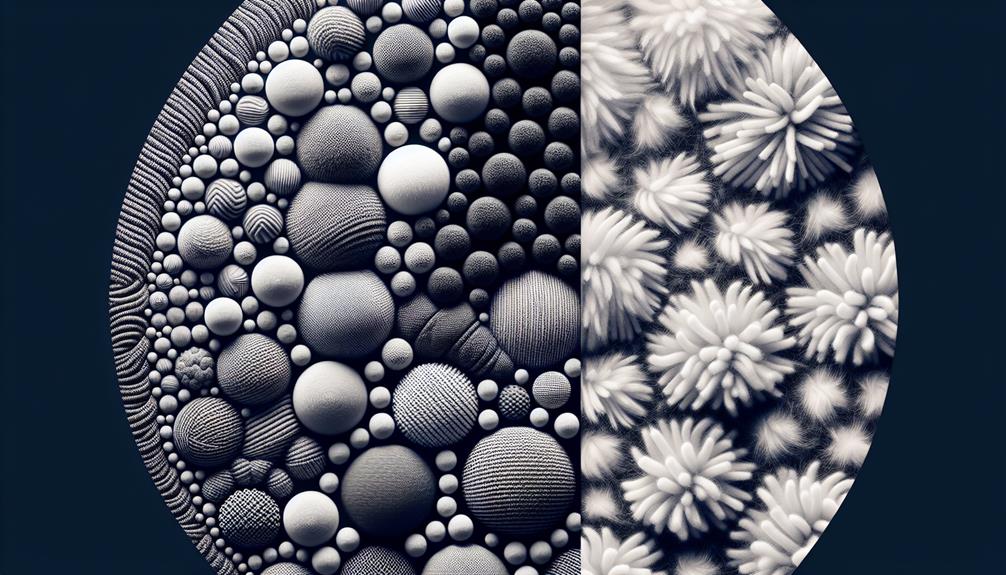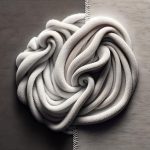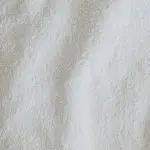Did you know that French terry and fleece fabrics have been gaining popularity steadily over the past few years, with a 20% increase in sales in the textile industry?
When it comes to deciding between these two cozy options, the choice might seem straightforward, but nuances exist that can make a significant difference in comfort and style.
Let's explore the characteristics of French terry and fleece in depth to help you make an informed decision for your next wardrobe addition.
Table of Contents
Key Takeaways
- French Terry is cotton-based with loops, offering a lightweight and breathable feel.
- Fleece, polyester-based, is plush and cozy, providing a luxurious softness.
- French Terry balances softness and breathability, suitable for various activities.
- Fleece excels in warmth, trapping body heat, and regulating temperature effectively.
Origins of French Terry and Fleece
Originating in the late 19th century, French Terry and fleece are two popular fabrics known for their softness and versatility. French Terry, with its historical origins dating back to France, was originally crafted from silk and wool. Over time, production methods evolved, leading to the use of cotton instead of silk, making it more affordable and widely accessible.
On the other hand, fleece, which emerged in the 1970s, was developed as a synthetic alternative to wool. Its production involves tightly woven synthetic fibers that create a plush, insulating fabric.
Both French Terry and fleece have gained cultural significance and global popularity due to their comfort and functionality. French Terry is often used in athleisure wear and casual apparel, offering a stylish yet cozy option. In contrast, fleece is commonly found in outerwear, blankets, and cold-weather gear, providing warmth without the bulk of traditional wool.
Despite their different production methods and historical backgrounds, both fabrics continue to be beloved for their softness and versatility worldwide.
Fabric Composition Differences
When comparing French Terry and fleece, the fabric composition variances play an important role in determining their unique characteristics and uses. Understanding these distinctions is key for selecting the right fabric for your needs.
Here are some key distinctions to keep in mind:
- Fabric Weight: French Terry is typically lighter in weight compared to fleece, making it a great option for layering or warmer weather.
- Breathability: French Terry tends to be more breathable than fleece, allowing for better airflow and moisture-wicking properties.
- Stretch: French Terry often has more stretch than fleece, providing better freedom of movement and flexibility.
- Drape: Fleece usually has a more structured drape, while French Terry has a softer, more relaxed drape.
- Composition: French Terry is usually made of cotton or a cotton blend, while fleece is often made of polyester or a polyester blend.
These distinctions in fabric composition greatly impact the overall feel and performance of each material, making them suitable for different types of garments and activities.
Texture and Feel Comparison
French terry and fleece differ in texture and feel. French terry typically has a smooth surface with loops on one side, while fleece is plush and soft all around.
Comparing their softness and comfort levels can help us understand how each fabric might suit different needs and preferences.
Fabric Texture Differences
Picking up a piece of French terry or fleece, one can immediately notice the distinct differences in texture and feel between the two fabrics.
- Fabric Texture Differences
- French terry: Loops on one side, smooth on the other, providing a textured feel.
- Fleece: Soft and fuzzy texture, often thicker than French terry.
- French terry: Lightweight and breathable, suitable for layering in various seasons.
- Fleece: Known for its warmth and coziness, ideal for colder weather.
- French terry: Offers a more casual look, great for athleisure wear.
These texture variances impact how the fabrics drape and wear, influencing the overall look and functionality of the garment.
Softness Comparison
Comparing the softness of French terry and fleece reveals distinct differences in texture and feel that play an important role in determining the comfort level of the fabric.
French terry, known for its looped pile back and smooth front, offers a balanced combination of fabric softness and breathability. It feels gentle against the skin, providing a cozy yet breathable sensation.
On the other hand, fleece, with its fuzzy surface, tends to be softer and warmer, offering a plush feel that many find comforting. The versatility of French terry lies in its ability to provide comfort without overheating, making it a great choice for various activities.
In contrast, fleece excels in providing exceptional warmth and a luxurious feel, ideal for cozy moments.
Touch and Comfort
When feeling the texture and comfort of French terry and fleece, the distinct differences in touch become immediately noticeable. French terry is typically looped on both sides, giving it a smooth surface on one side and a soft, textured feel on the other.
On the other hand, fleece has a plush and fuzzy texture that's incredibly soft to the touch. Here are some key points to take into account when comparing the touch and comfort of French terry and fleece:
- French terry: Known for its looped construction.
- Fleece: Features a plush and fuzzy surface.
- French terry: Offers a combination of smoothness and texture.
- Fleece: Provides a luxurious softness.
- Thermal properties: French terry is breathable, while fleece offers excellent insulation.
Understanding these differences can help you choose the fabric that best suits your comfort needs.
Warmth and Insulation Levels
When it comes to warmth and insulation levels, French terry and fleece have their own unique qualities to offer.
French terry provides a comfortable level of warmth, perfect for those in-between weather days.
On the other hand, fleece excels in insulation, making it a great choice for colder climates or outdoor activities.
French Terry Warmth
French Terry provides a comfortable level of warmth and insulation, making it a popular choice for various clothing items. When it comes to French Terry warmth, it excels in:
- Thermal properties: French Terry fabric traps body heat, keeping you warm in cooler temperatures.
- Moisture management: It wicks away sweat and moisture from the body, ensuring comfort during activities.
- Heat retention: The fabric retains warmth effectively, making it suitable for layering in colder weather.
- Breathability: Despite its warmth, French Terry remains breathable, preventing overheating.
- Comfort: It offers a cozy feel without being overly bulky, ideal for everyday wear while providing adequate insulation.
Fleece Insulation Levels
Moving from French Terry warmth to discussing fleece insulation levels, I can shed light on the varying degrees of warmth and insulation provided by fleece fabrics.
Fleece offers excellent insulation levels by trapping body heat, making it a popular choice for cold weather. When it comes to layering options, fleece can be a versatile mid-layer or outer layer depending on the temperature.
Its breathability allows for temperature regulation, preventing overheating during outdoor activities. Fleece is ideal for active pursuits like hiking or skiing, where staying warm without getting sweaty is critical.
Understanding the insulation levels of fleece can help you choose the right garment for your adventures, ensuring comfort and performance in varying weather conditions.
Moisture-Wicking Abilities
Moisture-wicking abilities play a major role in determining the comfort level of activewear fabrics. When comparing French Terry and Fleece in this aspect, it's crucial to understand how they handle moisture during physical activities.
Here are some key points to take into account:
- Sweat Absorption: Fabrics differ in their capacity to absorb sweat, impacting how dry and comfortable you feel during workouts.
- Quick Drying: The pace at which a fabric dries influences your overall comfort and helps regulate body temperature.
- Breathability: How well a fabric allows air to circulate affects sweat evaporation and comfort levels.
- Moisture Control: Fabrics that effectively manage moisture help keep you dry and prevent chafing or discomfort.
- Comfort: Ultimately, moisture-wicking abilities contribute significantly to the overall comfort and performance of activewear.
Understanding how French Terry and Fleece excel in sweat absorption, quick drying, breathability, moisture control, and overall comfort can guide you in choosing the right fabric for your active lifestyle.
Durability and Longevity Factors
When it comes to activewear fabrics, the durability and longevity factors are key considerations that impact the overall quality and performance of the material. In comparing French Terry and Fleece regarding durability, both fabrics have their strengths.
French Terry, known for its looped pile interior and smooth face, is generally more durable than traditional Fleece due to its tighter knit construction. This makes French Terry less prone to pilling and stretching over time, enhancing its longevity factors.
On the other hand, Fleece, with its fuzzy surface created by air pockets in the fabric, provides warmth and softness but may not be as durable as French Terry. Over extended use and multiple washes, Fleece can sometimes lose its softness and shape, impacting its longevity. If you prioritize durability in your activewear, French Terry might be the preferred choice between the two.
Considering both the durability comparison and longevity factors, opting for a fabric that not only suits your style and comfort needs but also holds up well over time is crucial to ensure a long-lasting and high-quality activewear piece.
Styling and Fashion Applications
Wondering how to effortlessly incorporate French Terry and Fleece into your everyday wardrobe for a stylish and fashionable look? Both fabrics offer incredible styling versatility and are on-trend with current fashion styles. Here are some tips to make the most out of these seasonal wardrobe essentials and create chic outfit combinations:
- Mix and Match: Pair a French Terry sweatshirt with tailored pants for a casual yet polished look.
- Layer Up: Combine a fleece vest with a button-down shirt for a cozy and stylish ensemble.
- Accessorize: Add a pop of color to your outfit by accessorizing with a French Terry scarf or a fleece beanie.
- Casual Chic: Dress up your fleece hoodie with a statement necklace and high-waisted jeans for a trendy vibe.
- Athleisure Vibes: Create a sporty-chic outfit by pairing French Terry joggers with a cropped top and sneakers for a comfortable yet fashionable look.
Maintenance and Care Tips
Let's now explore some practical tips to confirm the longevity and quality of your French Terry and Fleece garments through proper maintenance and care. When it comes to washing techniques, it is best to turn your French Terry and Fleece items inside out before placing them in the washing machine to protect the outer surfaces. Use cold water and a gentle cycle to prevent any damage. For stain removal, treat the affected area promptly with a stain remover suitable for the fabric type to increase the chances of successful stain removal without damaging the material. To combat fabric pilling, wash your garments inside out and consider using a fabric softener to reduce friction. When it comes to drying methods, air drying is preferable to maintain the shape and texture of your French Terry and Fleece clothing. Avoid high heat as it can cause shrinkage and damage the fibers. Remember, proper care confirms that your favorite pieces stay in top condition for longer.
| Care Tips | French Terry | Fleece |
|---|---|---|
| Washing Techniques | Turn inside out, cold water, gentle cycle | Turn inside out, cold water, gentle cycle |
| Stain Removal | Prompt treatment with suitable stain remover | Prompt treatment with suitable stain remover |
| Fabric Pilling | Wash inside out, use fabric softener | Wash inside out, use fabric softener |
Frequently Asked Questions
Can French Terry or Fleece Fabrics Be Used for Outdoor Activities Like Hiking or Camping?
For outdoor activities like hiking or camping, both French terry and fleece fabrics can be suitable. They offer good moisture wicking, breathability, and fabric durability, making them comfortable and practical choices for various outdoor adventures.
Are French Terry and Fleece Fabrics Suitable for People With Sensitive Skin or Allergies?
For those with sensitive skin or allergies, fabric breathability and allergen resistance are key. Look for materials like French terry or fleece with moisture-wicking properties to reduce skin irritation. It's essential for comfort outdoors.
How Do French Terry and Fleece Fabrics Compare in Terms of Environmental Sustainability and Ethical Production Practices?
When comparing sustainability, I find it essential to examine production methods. Ethical sourcing and environmental impact play key roles in determining the eco-friendliness of fabrics. Understanding these aspects helps make informed choices for a greener future.
Can French Terry or Fleece Garments Be Easily Tailored or Altered to Fit Different Body Shapes and Sizes?
I find that both French terry and fleece garments can be easily tailored or altered to fit different body shapes and sizes. Various tailoring options and alteration techniques allow for custom fitting and adjustments to accommodate individual body shapes effectively.
Are There Any Specific Dyeing or Printing Techniques That Work Better on French Terry Compared to Fleece, or Vice Versa?
When it comes to dyeing and printing techniques, certain ones shine on French terry while others excel on fleece. Tie-dye and screen printing pop on French terry, while block and digital printing stand out on fleece. Each fabric has its own canvas to showcase creativity.
- Why Is Red Velvet Not Red? - April 25, 2024
- How Do You Describe Velvet Fabric? - April 25, 2024
- How Strong Is Velvet? - April 25, 2024







